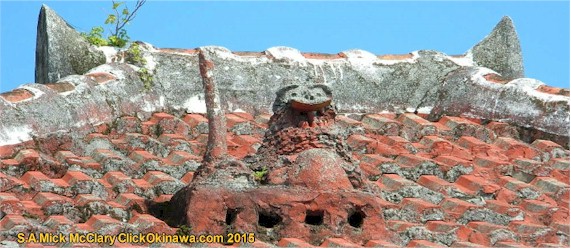
|
|
Okinawa's Red Tile Roofs
Nov 5, 2019
|
What makes Okinawa's red roof tiles so distinctive? They're not simply for show. Their composition, shape and placement serve well to defend against the elements of a sometimes harsh environment.
From the fifteenth to the nineteenth century, Okinawa and its surrounding islands comprised the Ryukyu Kingdom–a nation built on trade and independent from Japan. While Japan spent a majority of this same time frame relatively cut off from the rest of the world, the Ryukyu Kingdom thrived from its central location through trading with China, Japan, Korea, Siberia, Vietnam, Java, Sumatra, and more. Naturally, this cosmopolitan island nation developed a very unique and sophisticated culture of its own. One avenue in particular through which Ryukyuan culture found expression was in architecture. While politically the Ryukyu Kingdom is defunct, Ryukyuan visual culture lives on today as Okinawan architects find inspiration in the old.
Aka-gawara, or red earthenware roof tiles, are one of the first and most striking features of both traditional Ryukyuan as well as present-day Okinawan architecture. Aka-gawara look like this:
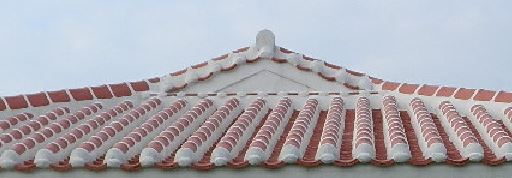 Roof of my house on Kadena Air Base, 1989
Ryukyuan roofs and their aka-gawara tiles are quite distinct from their Japanese counterparts:
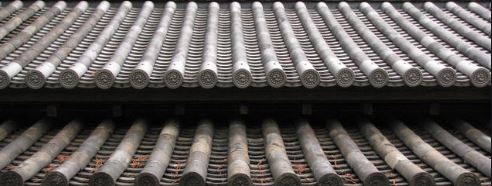
stock photo of typical Japanese roof tiles First, why are aka-gawara red? The Ryukyuan process of roofing and the aka-gawara that comprise said roof are a product of the island nation’s unique location and environment. Aka-gawara are made from kucha, black muddy soil found in the south of Okinawa Island. Although decidedly not red, kucha is rich in iron content which is key in producing the vermilion color that defines Ryukyuan architecture. In producing the tiles, manufacturers add water to a kucha mixture, mold the tiles, then let them dry for around forty days. After the wait, they use a firing process known as a bisque fire to bake the tiles. The unglazed tiles require a relatively low-heat fire at around one thousand degrees Celsius. It is at this point when the iron oxidizes and produces the aka-gawara‘s scarlet color. The resulting Ryukyuan tiles differ from standard Japanese roofing materials not only in their appearance. Okinawa’s unique materials and production methods result in a substance perfectly suited for the area’s particular environment. Kucha and the use of unglazed bisque firing creates properties of breathability and water absorbency. Spanning both tropical and subtropical zones, the Ryukyu Islands are even hotter and more humid than the Japanese mainland. Aka-gawara protect the wooden structure beneath its eaves from the brutal humidity by absorbing moisture into its surfaces. Not only are the Ryukyu Islands more sultry than mainland Japan, they face scorching sun known only to areas of similar latitude. Aka-gawara are quite resistant to said summer sun thanks again to the moisture stored within their unglazed faces. Moisture escapes the tiles during the day, and the resulting evaporation renders these tiles cooler than other roofing materials. In addition to the tiles themselves, Ryukyuan architecture makes use of a laying process yet again born from the kingdom’s unique location and environment. Roofers begin by laying rows of concave “female” tiles. The Ryukyu Islands face multiple typhoons throughout the year. Effectively laid tiles provide a chute for the torrential rain to slide off the roof without pooling. Next, roofers lay convex “male” tiles over the gap between rows of female tiles. Laying the convex male tiles over the remain gaps thereby prevents any other water from reaching the wooden structure below. Furthermore, Okinawa is the windiest prefecture in Japan. If builders were to follow Japanese practices of simply laying tiles on the roof, even the smallest typhoon would rip the tiles from the building.
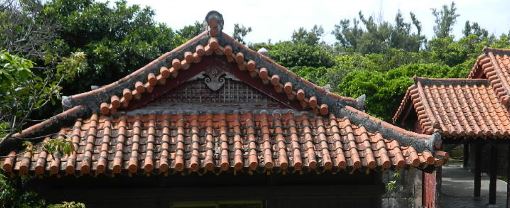
photo I took at Ryukyu Mura in 2015
|
 photo I took at Higashionna museum in 2015 The Ryukyuan solution was to cement the tiles down. Specifically, builders use a type of white mortar to bond the side edges and connecting joints of the convex male tiles. The mortar protects the tiles from flying away during the region's many typhoons. The result is a beautiful contrast of white mortar and scarlet earthenware tiles. Juxtapose this against the islands’ blue skies, green forested mountains, often turquoise waters, and coral sand beaches, and you are left with a gorgeous and vibrant aesthetic found only in this former tropical kingdom.
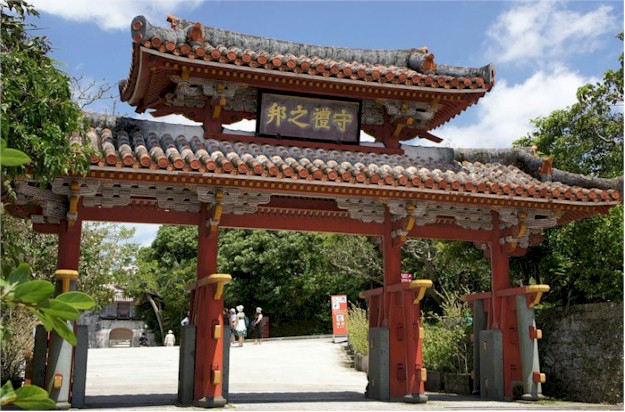
stock photo of Shureimon
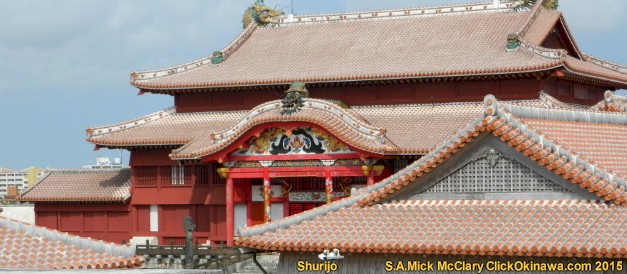
Gray tiles originally layered the roofs of the Ryukyu Kingdom. Around eighteenth century, red tiles appeared on Shuri Castle and have been the prominent type ever since. However, the Shuri government banned the use of aka-gawara among commoners. Structures that could make use of these scarlet tiles included temples, shrines, castles, prominent gates, sacred sites, tombs for nobility, and entrances and exits of villages among other structures of importance. The ban was lifted in 1889 after the Ryukyu Kingdom had been officially annexed to Japan as Okinawa Prefecture. Following the retraction of the ban, aka-gawara roofs proliferated across Okinawa, especially among households. Post WWII and subsequent eras brought an increased popularity in concrete buildings, but more traditional Ryukyuan architecture and the use of aka-gawara lives on today.
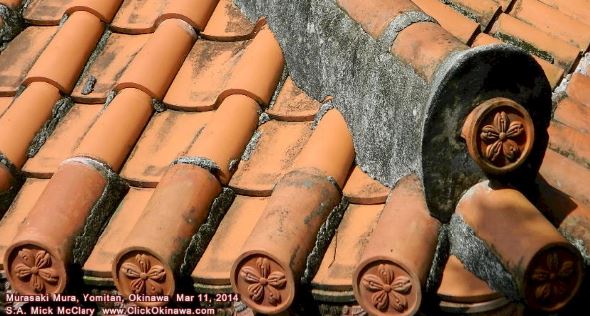
photo I shot at Ryukyu Mura With regards to aka-gawara, recent structures have taken typhoon-damage prevention to the next level and employ a laying process that involves screwing the tiles down and using less mortar. Planners of a new village office employed this method with the building’s roof in part due to the structure’s status as a public building and a focus on safety at its utmost. As with any building constructed with tax-payer money, cost reduction is also a very large factor, and the modern screw-down method invariably costs less than a roof that employs solely mortar.
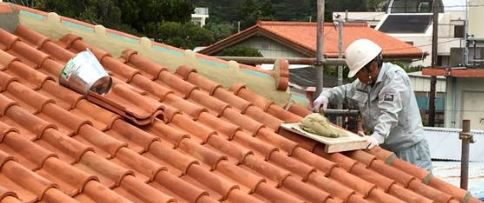
|
©2019 Contact: ClickOkinawa.com
